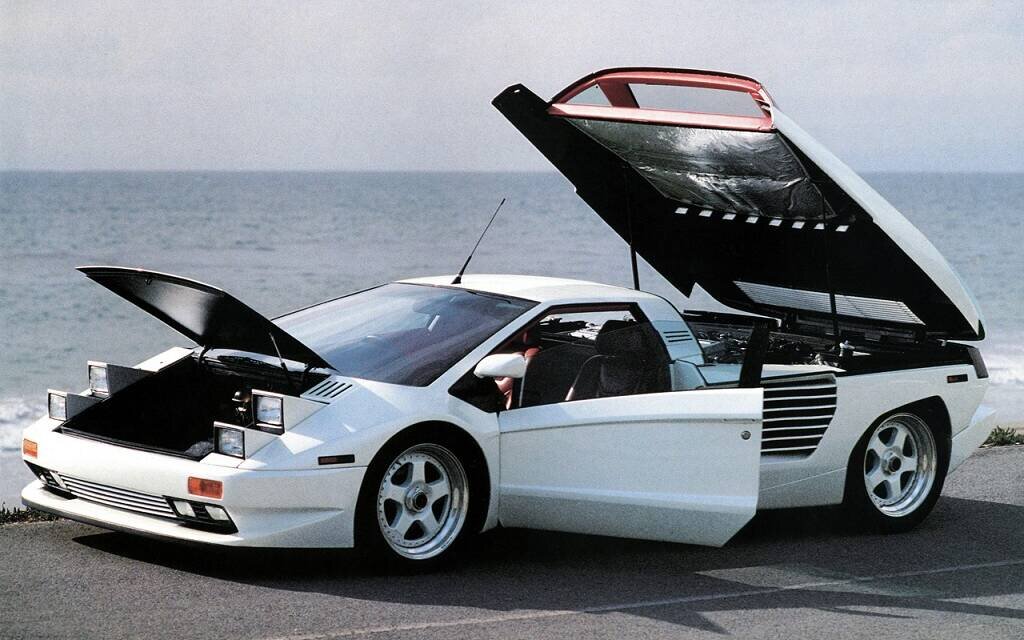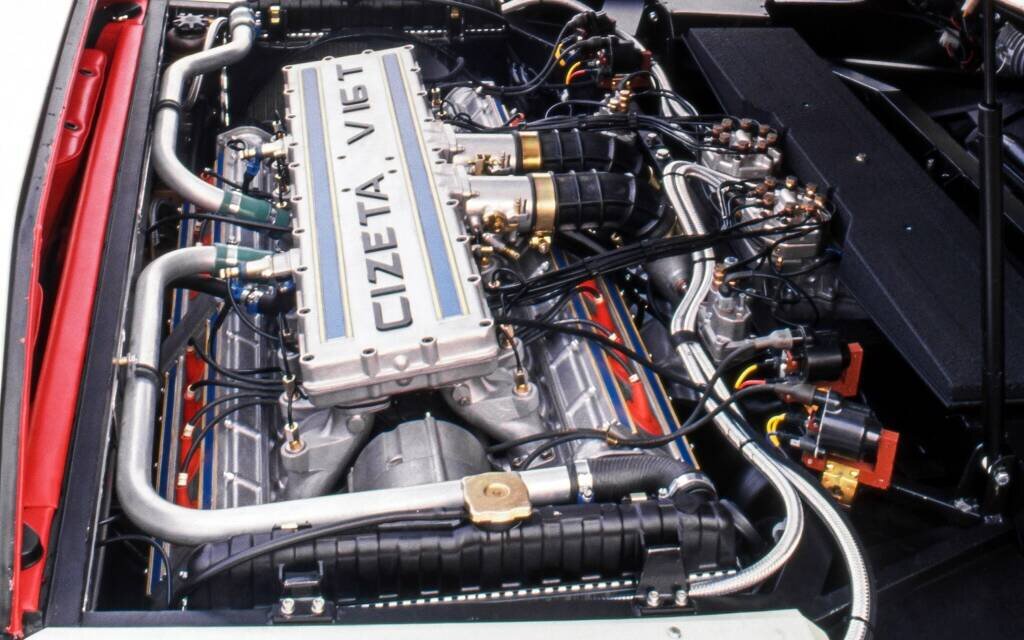On paper, the V16T had everything to succeed: enticing lines, a dream engine, prestigious parents… It could have been one of the supercars the most memorable of the 80s – 90s. In reality, things quickly turned sour…
The protagonist of our story is called Claudio Zampolli (the name Cizeta comes from his initials pronounced in Italian, CZ). Born in 1939 in Modena, in the Golden Triangle since Ferrari, Lamborghini and Maserati are located around the city, he was quickly fascinated by cars.
Claudio joined Lamborghini at the age of 25 and took part in the technical development of the Miura and the Countach. In the mid-1970s, he was sent to the United States to develop the American market. He likes California and decides to stay there. There he started a business selling and servicing Italian exotic cars which would flourish in the 1980s.
Photo: Cizeta
The Star Mechanic
Zampolli rubs shoulders with many stars in his shop, as they bring their cars to him for maintenance. For example, it was he who facilitated the meeting between Sammy Hagar and Eddie Van Halen in 1985 after the departure of David Lee Roth from the Van Halen group. We can also see Zampolli at the beginning of the Sammy Hagar clip I can’t drive 55 next to the singer’s Ferrari 512 BB.
Among his famous clients is Giorgio Moroder, who comes for the maintenance of his Lamborghini Countach. Moroder is a music producer, pioneer of electronic music and disco. He has also composed many film scores, for which he received three Oscars. The two men talk to each other. Zampolli talks about his old dream of creating his own car. For this, he is looking for investors (it seems that Sylvester Stallone was interested for a time). An agreement is reached: against 50% of the shares, Moroder provides the funds and Zampolli provides the technical expertise against the remaining 50%. Development can begin.

Photo: Cizeta
Logically, Zampolli goes where all the talents are: in the valley of Modena. He recruited several former Lamborghini employees: Oliviero Pedrazzi as chief engineer, Achille Bevini and Ianose Bronzatti for the suspensions and the chassis, and Giancarlo Guerra for the bodywork. Last, but not least, is Marcelo Gandini. This designer worked for Bertone from 1965 to 1980, where he created the Lamborghini Miura and Countach, the Alfa Romeo Carabo and Montreal, the Lancia Stratos and the Fiat X1/9. After 1980, he opened his own style office to design the Citroën BX, Renault Super Cinq and Bugatti EB110.
Gandini does not arrive at Zampolli empty-handed. He has with him the drawings he signed for the future Lamborghini Diablo. But they were tweaked by designers at Chrysler (which bought Lamborghini in 1987), much to Gandini’s displeasure. Zampolli likes the front part, with its 4 retractable headlights, on the other hand, the rear is not to his liking. The two men rework the rear of the car. Because that’s where, as we’ll see, it all happens.

Photo: Cizeta
A heart that big!
It’s the 6.0-liter V16 installed behind the seats that is obviously the mainstay. Zampolli selected this type of engine because, in his view, V12s were becoming too common. However, the manufacturer did not choose the facility by placing it in a transverse position. If it is reminiscent of two V8s joined (taking up the architecture of the V8 of the Lamborghini Urraco P300), the block is actually cast in one piece. On the other hand, the valve drive is done in the middle and not on the side, which implies that there are 8 camshafts instead of 4 long ones to activate the 64 valves. These are two crankshafts which deliver their power to the gearbox (a ZF S5-42 manual 5-speed), placed longitudinally. There are two K-Jetronic injection systems, one for each side. The package deploys 540 horsepower at 8,000 rpm and 400 lb-ft of torque at 6,000 rpm. It should be remembered that in 1989, the V12 of a Lamborghini Countach generated 455 horsepower and the flat 12 cylinders of a Ferrari Testarossa spit out 380 horsepower.

Photo: Cizeta
Such an engine layout results in a very wide rear: 2.05 meters (against 1.98 meters for the already imposing Ferrari Testarrossa). At 4.49 meters, it is also longer than the Countach (4.20 meters). The chassis is a tubular steel frame with an aluminum body. Brakes are supplied by Brembo, shock absorbers by Koni, wheels by OZ and tires by Pirelli (245/40-ZR17 front and 335/35-ZR17 rear). The weight of the first prototype is 1,702 kilos, Zampolli hopes to bring it down to 1,407 kilos for the production versions. The V16T promises breathtaking performance: 328 km/h peak and 0 to 100 km/h in 4 seconds (against 300 km/h and 5.5 seconds for a Testarossa or 298 km/h and 5 seconds for a Countach) . You should know that the car has never been in the wind tunnel, Zampolli’s logic being “If Lamborghini doesn’t do it, why should I do it? “. As for high-speed stability, well, we’ll see when we get there… The interior is simple but well finished with, and this is quite surprising in an exotic car, a rather limited instrumentation.

Photo: Cizeta
Breaking
The Cizeta Moroder V16T, in the form of a white prototype, was officially presented on December 5, 1988 at the Century Plaza Hotel in Los Angeles during a very social evening. The master of ceremonies is Jay Leno. The car imposes with its lines, its technical characteristics and its performance. The enthusiasm is palpable and Cizeta Moroder intends to manufacture between 50 and 100 cars per year. The Cizeta then left for the Los Angeles and Geneva Motor Shows in March 1989. It was there that the company took its first orders (the V16T was initially designed for the North American market but it was never homologated there from the point of view of pollution standards, a fact that will greatly limit its potential).
On the strength of this, Zampolli returns to Modena and starts production… very slowly, because this gentleman is a perfectionist. Much to the chagrin of Moroder, who wishes things went faster. He discusses with the eccentric German tuner Uwe Gemballa the possibility of making a fiberglass body and installing a standard BMW engine instead of the V16. Which, in turn, displeases Zampolli. Quickly, it is the discord between the two men. Moroder withdrew his marbles from the business in 1990 and left, in the form of compensation, with the white prototype.
Cizeta Moroder becomes Cizeta and the company finds itself with almost empty coffers. Never mind, Cizeta manages to produce with difficulty and misery 9 vehicles between 1991 and 1995 (including two for the Sultan of Brunei). During this period, the price of the car exploded, going from US$280,000 to US$650,000 against US$161,600 for a Testarossa and US$211,000 for a Diablo in 1991). Finally, the economic crisis in Asia of 1991-1992, where the V16T sold best, ended up burying the project.

Photo: Cizeta
The sequel and lawsuits
Zampolli was not discouraged and in 1995, he repatriated all his tools to California to try to continue the adventure. He managed to produce two more vehicles: one in 1999 and an exclusive convertible (named Fenice TTJ Spyder) in 2003 for a Japanese customer. It was also in 1995 that the setbacks multiplied: Zampolli’s personal bankruptcy, several lawsuits from dissatisfied customers (including one for 150 million against Jay Leno for defamation, which did not succeed), the intervention of customs… Yet , Zampolli does not give up and the Cizeta is still offered on special order until 2018… without success. He will die in July 2021 at the age of 82 without having been able to realize his dream.
As for Gorgio Moroder, he will keep his car (the only model bearing the name Cizeta Moroder) in storage for all these years before deciding to have it restored in 2018. It is Jay Leno himself who advises him to bring it at Bruce Canepa, in Scotts Valley, California. There, technicians work more than 1,000 hours on the vehicle. It is a prototype, there are many unique parts and there is no documentation. The V16T finally went to auction on January 27, 2022 at RM Sotheby’s in Arizona. The winner will pay $1,363,500 to get it. A little posthumous success in a way.
If Zampolli and Moroder hadn’t gotten angry, if the car had been homologated in America, if the Asian crisis hadn’t happened, perhaps the V16T could have entered the pantheon of supercars. But with if…
